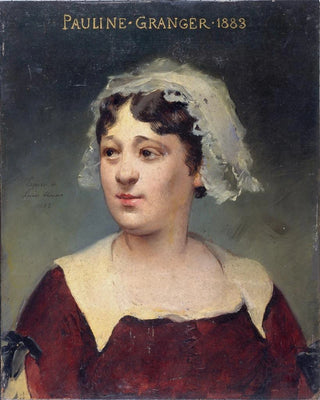Art print | Portrait of Pauline Granger 1833-1913 Sociétaire of the Comédie-Française - Louise Abbéma


View from behind

Frame (optional)
Portrait of Pauline Granger 1833-1913 Member of the Comédie-Française - Louise Abbéma – Captivating introduction
In the fascinating world of art, some works transcend the mere frame to become living testimonies of an era and its personalities. The "Portrait of Pauline Granger 1833-1913 Member of the Comédie-Française" by Louise Abbéma is one of those creations that capture the essence of a remarkable woman, embodying both beauty and talent. This painting, created by a pioneering artist, immerses us in the theatrical universe of the early 20th century, where the Comédie-Française stood as a bastion of dramatic art. Through this portrait, Louise Abbéma invites us to discover not only the figure of Pauline Granger but also the vibrant atmosphere of her time.
Style and uniqueness of the work
Louise Abbéma's style is distinguished by a delicacy and finesse that characterize her portraits. In this work, she manages to combine an impressionist technique with a more academic approach, creating a captivating visual harmony. The features of Pauline Granger are rendered with meticulous precision, while the choice of colors evokes a softness and warmth that seem to emanate from the painting. Light plays a crucial role, illuminating the actress's face and highlighting her expression, both serene and full of life. Every detail, from the drape of her dress to the sparkle in her eyes, contributes to a lively and emotive representation. This portrait does not merely depict a figure; it tells a story, that of a woman who left her mark on the world of theater and continues to inspire.
The artist and her influence
Louise Abbéma, born in 1853, is an emblematic figure of the artistic movement of her time. She managed to establish herself in a male-dominated environment, becoming one of the few women to be a member of the Comédie-Française. Her work is marked by a deep commitment to her subjects, whom she portrays with rare sensitivity. Abbéma captured the spirit of her era by blending realism and romanticism, while exploring themes of femininity and emancipation. Her influence extends beyond her own

Matte finish

View from behind

Frame (optional)
Portrait of Pauline Granger 1833-1913 Member of the Comédie-Française - Louise Abbéma – Captivating introduction
In the fascinating world of art, some works transcend the mere frame to become living testimonies of an era and its personalities. The "Portrait of Pauline Granger 1833-1913 Member of the Comédie-Française" by Louise Abbéma is one of those creations that capture the essence of a remarkable woman, embodying both beauty and talent. This painting, created by a pioneering artist, immerses us in the theatrical universe of the early 20th century, where the Comédie-Française stood as a bastion of dramatic art. Through this portrait, Louise Abbéma invites us to discover not only the figure of Pauline Granger but also the vibrant atmosphere of her time.
Style and uniqueness of the work
Louise Abbéma's style is distinguished by a delicacy and finesse that characterize her portraits. In this work, she manages to combine an impressionist technique with a more academic approach, creating a captivating visual harmony. The features of Pauline Granger are rendered with meticulous precision, while the choice of colors evokes a softness and warmth that seem to emanate from the painting. Light plays a crucial role, illuminating the actress's face and highlighting her expression, both serene and full of life. Every detail, from the drape of her dress to the sparkle in her eyes, contributes to a lively and emotive representation. This portrait does not merely depict a figure; it tells a story, that of a woman who left her mark on the world of theater and continues to inspire.
The artist and her influence
Louise Abbéma, born in 1853, is an emblematic figure of the artistic movement of her time. She managed to establish herself in a male-dominated environment, becoming one of the few women to be a member of the Comédie-Française. Her work is marked by a deep commitment to her subjects, whom she portrays with rare sensitivity. Abbéma captured the spirit of her era by blending realism and romanticism, while exploring themes of femininity and emancipation. Her influence extends beyond her own






